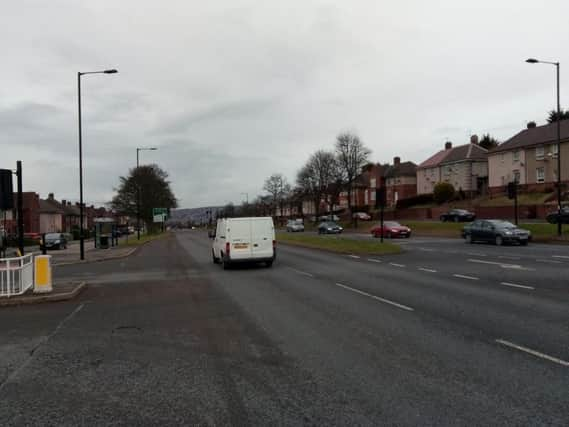Drivers' lottery over pothole compensation in South Yorkshire


MOTORISTS face a lottery over their chances of success over claims for damage caused by pot holes in South Yorkshire with drivers challenging Sheffield Council seven times more likely to get paid out as those in neighbouring Rotherham.
Statistics for the county’s four local authorities reveal drivers’ chances of getting compensated for damaged caused by pot holes vary wildly and reveal that Sheffield – now six years into a private finance initiative contract to revamp the city’s roads – has by far the worst record in South Yorkshire, even when the size of the city is taken into account.
Advertisement
Hide AdAdvertisement
Hide AdThirty two per cent of motorists who made claims for damage in Sheffield ended up being paid out, compared to only four per cent across the border in Rotherham – even though both authorities have been pumping money into improving roads.
Rotherham Council has made extra cash available for its own maintenance crews while in Sheffield the council signed up a 25 year private finance initiative contract – called Streets Ahead - with the company Amey.
In Barnsley the success rate was around 25 per cent and in Doncaster around 30 per cent.
That volume of successful claims meant the cost to Sheffield Council also dwarfed the other authorities, costing a total of around £77,000, compared to £66,000 for the rest of the county combined.
Advertisement
Hide AdAdvertisement
Hide AdClaims in Sheffield have been in decline over that period and successful claims fell from 90 in the 2015/16 year to 25 in the following 12 months and currently stand at five for the present financial year, though some claims may yet to be resolved for that period.
The success of compensation claims is dictated by how well local authorities can defend themselves against claims, with the law not expecting them to compensate in cases where holes in the carriageway were not known to exist.
Amey have defended the city’s track record on pot hole claims, saying “We’ve hugely improved the city’s infrastructure and there’s been a steady and corresponding fall in the number of damages claims for potholes.”
But the company accepts that every claim represents someone who has suffered damage and added: “The only truly successful number would be zero. In that respect we still have some way to go.
Advertisement
Hide AdAdvertisement
Hide Ad“We have now completed resurfacing on around two thirds of the city’s roads and pavements and over the next few years we will be upgrading the remaining roads and maintaining them.”
However, the AA is critical of Sheffield’s performance on potholes with Jack Cousens, head of roads policy saying: “With such a gap between the percentage of compensation payouts made, it seems Sheffield could learn something from Rotherham.
“By paying out £77,000 in compensation, Sheffield has missed the chance to fill over 1,000 potholes.
“Residents would much rather see their council tax be spent on fixing the roads rather than compensation claims.
Advertisement
Hide AdAdvertisement
Hide Ad“Filling potholes not only reduces the number of claims, but improves road safety for vulnerable road users, especially cyclists and motorcyclists.”Rotherham Council has worked hard to ensure its roads are kept in good order, with the council recently putting more money into maintenance work.
But it also has a team of highly trained inspectors who are being trained with formal industry qualifications and who are expected to take a cautious approach to ordering repairs – meaning roads should not be allowed to deteriorate too badly before action is taken. Highways bosses believe that level of expertise helps with their legal defence against claims.
When inspectors find extreme damage, they are also expected to stay at that location to guard against accidents until a repair team can get to the scene, with a four hour deadline expected.
Head of highway services, Colin Knight, said the council’s objective was to keep roads save and to maintain them cost effectively.
Advertisement
Hide AdAdvertisement
Hide AdIt is now adopting a new inspection regime, with added flexibility to help ensure known blackspots for pot holes get more attention than recently rebuilt carriageways.
He said: “Over the last five years we have seen a downward trend in highways claims. I am sure it is a reflection of our good practice, being where we need to be.
“In the last 12 months we have seen a decrease in pot holes over previous years.”
Despite that, the biggest single payout by any authority in the period covered was £4,400 for a claim made against Rotherham Council.
Advertisement
Hide AdAdvertisement
Hide AdBarnsley Council found its biggest payments in both 2015/16 and last year were on the same road.
In each of the last five years in Sheffield, the biggest single payouts have been as a result of incidents in Nether Lane, at £2,725 during 2013/14 and in the following years at Halifax Road (£3,300), Lumley Street (£1,970), Stoney Ridge Road (£1,000) and Attercliffe Road (£500).
For Rotherham the figures and locations are Haugh Lane, Rawmarsh (£2,529), Woodsetts Road, North Anston (£1,167), Pontefract Road, Brampton Bierlow (£1,813), A57 South Anston (£4,400), Sheffield Road (£235).
In Docaster the highest annual payments were for incidents at White Ley Road (£3,242), Power Station Road (£1,044), Kings Road, Askern (£1,189), Moor House Lane (£1,791), Spring Lane (£833).
Barnsley’s figures were for Woodhead Road (£2,000), Flint Lane (£690), Long Lane (£3,059), Long Lane (£1,294), the A61 (£277).